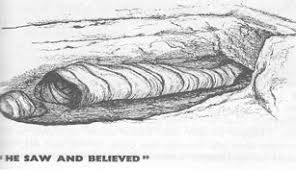
We continue our meditation on the death, burial, and resurrection of Jesus and look today at the resurrection itself. The writer, Josh McDowell, tried to disprove the resurrection story for his college thesis, but as he began to study the Scriptures and the evidence from history, logical reasoning led him to the opposite conclusion. The evidence he uncovered affected him to his core, leading him to become a Christian and write “Evidence that Demands a Verdict,” which has become one of our most popular Christian books. It indeed illuminates the whole resurrection story. The climax of this story, i.e., Jesus’ rising from the dead, gives us all a foretaste of the victory we can expect to experience as believers in Christ. Death had no power over Jesus and will have no power over believers in Him.
Having watched where Joseph and Nicodemus put the body, it is likely that the women, having different homes where they were staying, decided to meet at dawn at the tomb to put more spices on the body. The first there that morning was Mary Magdalene. She came alone while it was still dark:
1Early on the first day of the week, while it was still dark, Mary Magdalene went to the tomb and saw that the stone had been removed from the entrance. 2So she came running to Simon Peter and the other disciple, the one Jesus loved, and said, "They have taken the Lord out of the tomb, and we don't know where they have put him!" 3So Peter and the other disciple started for the tomb. 4Both were running, but the other disciple outran Peter and reached the tomb first. 5He bent over and looked in at the strips of linen lying there but did not go in. 6Then Simon Peter, who was behind him, arrived and went into the tomb. He saw the strips of linen lying there, 7as well as the burial cloth that had been around Jesus' head. The cloth was folded up by itself, separate from the linen. 8Finally the other disciple, who had reached the tomb first, also went inside. He saw and believed. 9(They still did not understand from Scripture that Jesus had to rise from the dead.) (John 20:1-9).
When Mary Magdalene told the two disciples of the stone removed from the tomb's entrance, they assumed the Jewish priests and elders had stolen Jesus' body. Mary told Peter and John, “They have taken the Lord out of the tomb, and we don’t know where they have put him!” (John 20:2). When they ran to the tomb, and John entered, he believed (v. 8), but what was it that he believed? He became convinced that Jesus had risen when he saw the grave clothes. He was the first to "get it." Let's think about what John saw when he looked at the burial wrappings. We know the body was wrapped in linen strips (John 19:40) with spices between the wrappings, similar to the wrapping Egyptian style. The head wrapping was separate from the rest. The way I imagine it, the wrappings were probably stiff from the myrrh, aloes, and spices. The body passed through the wrappings, leaving something that could be said to resemble a cocoon of wrappings and spices. These intact wrappings are what I believe John saw that convinced him that Jesus was alive.
It is interesting to consider that when Mary Magdalene finally got back to the tomb and entered it, she saw two angels on either side of the linen burial wrappings:
11Now Mary stood outside the tomb crying. As she wept, she bent over to look into the tomb 12and saw two angels in white, seated where Jesus’ body had been, one at the head and the other at the foot (John 20:11-12).
As Mary looked inside the tomb, there were two attending angels at the head and the feet of the burial wrappings. The two angels in the tomb were symbolic of the Holy of Holies inside the temple, where on either side of the Mercy Seat, where the high priest sprinkled the atoning blood, stood two statues of angels cast in gold (Exodus 25:18). Christ's empty tomb now symbolized the very mercy seat of God. It is also interesting to consider that Jesus was wrapped in white linen, just as the high priest had to wear a white linen garment to sprinkle the blood of the atonement before God. What does atonement mean? To atone is to suffer the penalty for sins, thereby removing the effects of sin from the repentant sinner and allowing him or her to be reconciled to God.
What impact does this have on our lives? If we believe Christ has risen, there must be an individual response to His claims. Each person must decide if He is your King. Thank God we serve a risen Savior! Keith Thomas
The YouTube video of this talk with closed captions (subtitles) in 65 languages is found at the following link: https://youtu.be/OSV2bnALI6w
The written notes are at the following link, Study 64, The Resurrection of Christ.


Comments